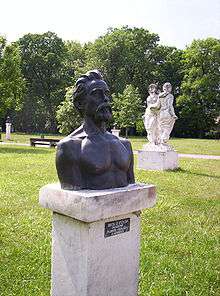Fülöp Ö. Beck
Fülöp Ö. Beck (1873–1945) was a Hungarian sculptor noted for his medal sculptures of Endre Ady, Sándor Petőfi, Ferenc Liszt, Mihály Babits and Kelemen Mikes creating over 500 in his career. Later in his career he created notable busts of Zoltán Kodály and Zsigmond Móricz and various tombs and developed a post-impressionism style influenced by elements of Art Nouveau.

Biography
Beck was born in Pápa, in 1873. In 1888 he studied the goldsmith's craft at the School of Applied Arts in Budapest until 1893 when he after visiting Vienna travelled to Paris on a scholarship the following year. In Paris he participated in a competition which was to create the medal of the Millennium Exhibition. He won while he was the pupil of Ponscarme at the École des Beaux-Arts in Paris in 1895. In 1898 exhibition he exhibited his medals at the Museum of Industrial Design, the first year than medals had been showcased, later winning a silver medal at the World Exhibition in Paris in 1900. He spent a number of years in Germany and in Italy where he won the Grand Prix in Milan in 1906.[1]
In Milan who grew interested in creating statues and moved back to his country, opening up a workshop in Göd. His earlier works include Animal Reliefs in 1911, Saint Sebastian in 1914, and Aphrodite in 1915 and was contracted to sculpturally decorate the Corvin department store in Budapest in 1916.
In 1928 he began working on tombs and memorials creating the Tomb of Baumgarten and Fellner's tomb in 1932, the Ferenc Liszt Memorial in 1935 and the Kölcsey Memorial, and Iron Founders in 1943).
He died in 1945.
References
- ↑ Fine Arts in Hungary – BECK Ö., Fülöp at the Wayback Machine (archived May 11, 2006)